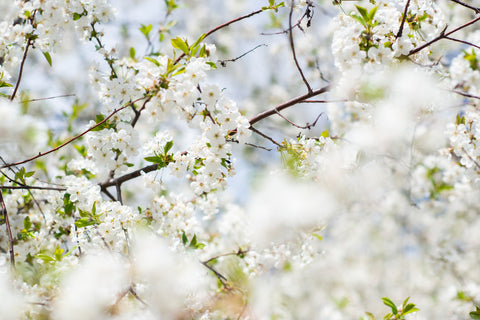Have you ever stood beneath a blooming cherry blossom tree, mesmerized by its delicate petals and serene beauty? They, known as 'sakura' in Japanese, are celebrated worldwide for their breathtaking appearance and the symbolic meaning they carry. Each year, as winter fades, these trees put on a spectacular show that heralds the arrival of spring, drawing people from all corners of the globe.
Blossom season is not just a time to admire nature’s beauty; it’s a cultural phenomenon that inspires festivals, art, and gatherings. Whether you’re walking through the pink blossom-laden streets of Tokyo or enjoying the view of a white cherry blossom in a quiet park, the experience is unforgettable.
In this blog, we’ll explore the different varieties of trees and how you might even start your own cherry blossom garden.
• Understanding Cherry Blossom Season

Blossom season is a herald of spring, marked by the spectacular blooming of cherry blossom trees. This season is not only a visual treat but also a temporal phenomenon, as the blossoms typically last for only a couple of weeks before the petals fall. The timing of the blossom season varies greatly depending on geographic location and climatic conditions. For instance, in Japan, the blossoms might start blooming as early as January in subtropical regions like Okinawa, while in Hokkaido, flowers might not appear until May.
In many parts of the world, the arrival of blossoms is celebrated with cultural festivities. In Japan, people engage in "Hanami," a traditional custom of enjoying the transient beauty of flowers, often with picnics under the blooming trees. Similarly, in Washington D.C., the National Cherry Blossom Festival attracts thousands of visitors who come to marvel at the pink and white blossoms. These celebrations not only honor the beauty of the blossom trees but also signify renewal and the fleeting nature of life, encouraging people to pause and appreciate the beauty around them.
• Types of Cherry Blossom Trees
In exploring the various types of blossom trees, three standout varieties each bring their own unique beauty and character to landscapes around the world:
1. Japanese Cherry Blossom

Symbolic of spring in Japan, the Sakura tree is perhaps the most famous type of blossom. These trees are celebrated during the Sakura season, where people partake in Hanami, the traditional custom of enjoying the beauty of flowers.
Sakura trees typically produce light pink to nearly white blossoms that cover the branches in a breathtaking display, marking a time of renewal and joy.
2. White Cherry Blossom

White blossoms are known for their pure and elegant white flowers. These trees offer a serene and pristine look, making them a popular choice for creating peaceful and attractive settings in parks and gardens.
The White blossom trees are particularly striking when planted in rows, creating a luminous effect with their abundant, bright blooms.
• Some Other Blossom Tree Types
1. Plum Blossom

Plum blossoms, often confused with cherry blossoms, are one of the first heralds of spring in many East Asian cultures, especially in China and Japan. Characteristically, plum blossoms have a deeper pink or sometimes red color, and unlike cherry blossoms, their petals are rounded and often appear more spaced apart on the branch.
Each blossom usually consists of five petals, and they emit a strong, sweet fragrance that is much more pronounced than that of cherry blossoms. They are an excellent choice for those looking to extend the blossom season in their gardens.
2. Peach Blossom

Peach blossoms are another captivating spring flower, sharing the same botanical family with cherry and plum blossoms. They typically bloom slightly later than plum blossoms but before most cherry blossom varieties. Peach blossoms range in color from light pink to an almost crimson shade, making them a vivid addition to any landscape.
The flowers usually emerge before the leaves, covering the branches with dense clusters of bright blooms, creating a striking visual impact. In addition to their beauty, peach blossoms are also known for their sweet, delicate aroma
• Tips for Growing Your Own Blossom Tree
Here are some practical tips to help you successfully cultivate and care for a cherry blossom tree:

1. Select the Right Variety
Choose a blossom tree that suits your local climate and soil conditions.
2. Choose a Good Location
Plant your tree in a spot that receives full sunlight and has well-draining soil.
3. Planting Time
The best time to plant blossom trees is in the fall or early spring.
4. Watering
Keep the soil consistently moist, especially during the first few years and in dry periods.
5. Fertilizing
Apply a balanced fertilizer in early spring before the flowering season begins.
6. Pruning
Prune in late summer or fall to shape the tree and remove any dead or overcrowded branches.
7. Pest and Disease Management
Regularly check for signs of pests and diseases, and treat them promptly to keep the tree healthy.

Cherry blossoms are more than just beautiful trees; they symbolize renewal and the fleeting nature of life, reminding us to appreciate the present moment. Whether you plan to visit a famous cherry blossom festival, enjoy a walk through a cherry blossom garden, or decide to grow your own blossom tree, each experience offers a unique way to connect with nature and celebrate the arrival of spring.
By embracing the charm and cultural significance of these magnificent trees, you can bring a touch of their timeless beauty into your life, creating memorable moments that resonate with the spirit of the season.
















